A First-Timer's Guide to Clamming on Oregon's Adventure Coast
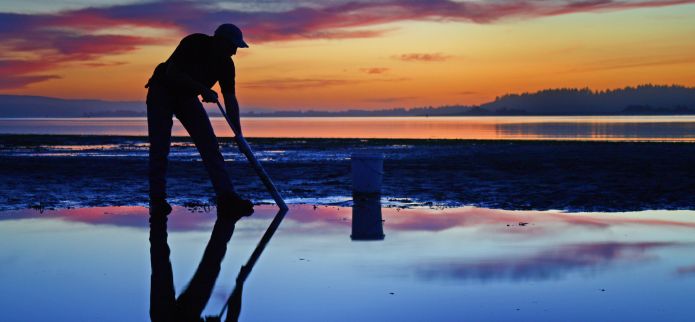
Grab Your Buckets and Shovels- It’s Clamming Time on Oregon’s Adventure Coast: Coos Bay, North Bend, Charleston!
We hear a lot of pros and cons about Daylight Savings Time, but on Oregon’s Adventure Coast: Coos Bay, North Bend, Charleston - we embrace it! Residents and visitors now have an extra hour of low tides during daylight, which is excellent news for people who “dig” clamming!
The abundance of mudflats along the Southern Oregon Coast makes this region a prime destination for clamming, with favorable conditions expected through spring, summer, and fall. On Oregon’s Adventure Coast, you’ll find a variety of species—gaper, cockle, littleneck, softshell, and butter—and the best-tasting clams are the ones you dig yourself.
First-time clammers are often relieved to learn that no special skills or expensive gear is required to enjoy a clamming adventure . If you can use a shovel, you can dig clams! For an easy-to-follow clamming lesson for beginners, we recommend thisOregon Department of Fish and Wildlife video:
In this post, we will walk you through helpful tips every first-time clammer needs to know, from the best places and times to go on Oregon’s Adventure Coast to gear you will need, easy-to-learn techniques, and what to do with your tasty haul. Grab your boots and your shovels, and let’s get digging!
When & Where To Go Clamming on Oregon’s Adventure Coast
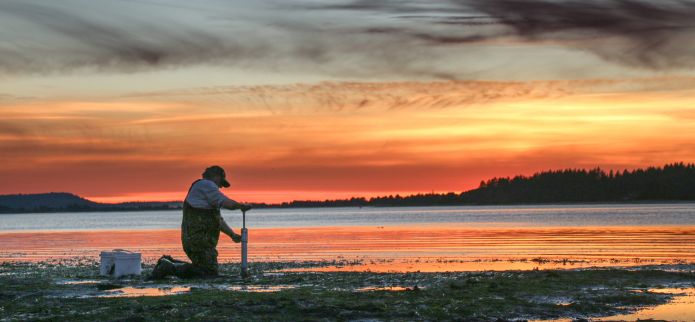
When to go. Clams can be harvested year-round on the Oregon Coast, but low tide is the golden window for clammers. Plan your outing for when the tide is at its lowest (zero or “minus” tides are ideal) so that the bay’s extensive mud flats are exposed. Early mornings often coincide with low tides, meaning a quieter bay and a better chance to chat with friendly local clammers who can share tips.Check local tide tables or pick up a tide book when you get your license. Tide books are also available at the area Visitor Information Centers in Coos Bay, North Bend and Charleston.
Where to go. Oregon’s Adventure Coast: Coos Bay, North Bend, Charleston offers several prime locations for clamming, but as a first-timer, you’ll likely want to stick to these convenient, well-known flats.
- Clamming in Lower Coos Bay. Mudflats in Coos Bay’s Empire district (by the old Empire docks) are great for digging gaper and butter clams – there’s even a city parking area by Fulton Ave for easy access. The lower bay is “marine dominated,” meaning there is little freshwater influence, which makes for some of Oregon’s most productive shellfishing opportunities. Be sure to download our map-Clamming Locations - Lower Coos Bay .
- Clamming in Charleston. In the Charleston area, broad-tide flats like the Charleston Triangle and Charleston Flat are easily accessible and rich with clams. At Point Adams (reached at the end of Boat Basin Road in Charleston), you can rake the sand for large cockle clams at low tide. Rental shops are nearby to help those new to clamming gather the right gear and find the best spots. Be sure to download our map-Clamming Locations - Charleston Area .
Licenses and Local Regulations
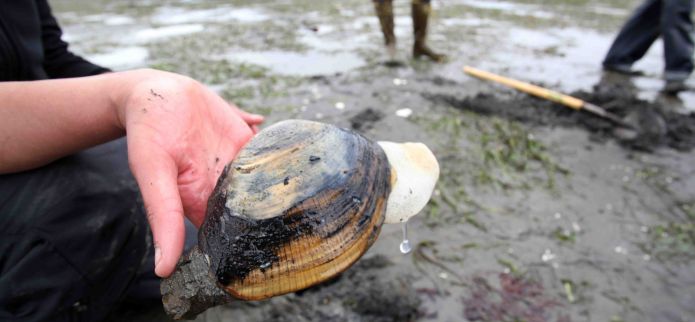
Before you dig your first clam, make sure you have the necessary shellfish license and check for any currentregulations or advisories from the Oregon Department of Fish and Wildlife . Anyone 12 years or older in Oregon needs a shellfish license to harvest clams or crabs. You can buy a daily or annual license online via the Oregon Department of Fish & Wildlife (ODFW) or pick one up at local outlets (Bi-Mart, Walmart, or tackle shops in Coos Bay/North Bend often sell licenses). The process is quick and affordable – a small investment for all the clamming fun ahead.
Even though clamming on Oregon’s Adventure Coast is almost always open, it is recommended that visitors and locals check for any temporary closures or health advisories before heading out by calling the Oregon Health Authority shellfish safety hotline (1-800-448-2474) or checking theirwebsite .
Gearing Up: What to Wear and Bring
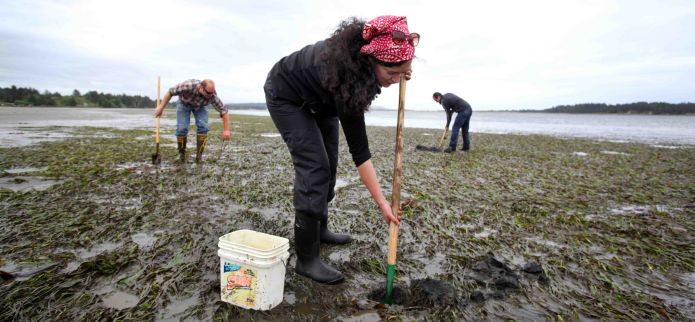
Clamming can be delightfully messy and typically involves walking through mud and/or shallow water, so dress for the occasion. Waterproof boots are a must (trust us – sneakers will get soaked and likely ruined). Wear clothes you don’t mind getting dirty and dress in layers. A rain jacket or windbreaker over a sweatshirt is common clamming attire. Don’t forget gloves if you want to keep your hands clean or protect from sharp shells!
As far as tools and supplies, it’s pretty minimal! You’ll need to have a bucket or mesh bag to hold your clams and a digging tool. Many clammers use a short-handled shovel, while others prefer a clam “gun” or pump – a tube (often PVC) used to suction sand up (more on this technique shortly). A simple garden hand trowel can work for smaller clams, and a sturdy rake is helpful if you plan to gather cockles near the surface.
Bring a mesh screen or colander if you intend to rinse sand off the clams on-site. It’s also wise to pack some fresh water and towels to clean up afterward and perhaps a small cooler with ice packs to keep your clams cool on the drive home. Finally, carry a tide chart or have a tide app on your phone, and consider a notepad or phone app to tally your clams as you collect them (to stay within limits).
How to Clam
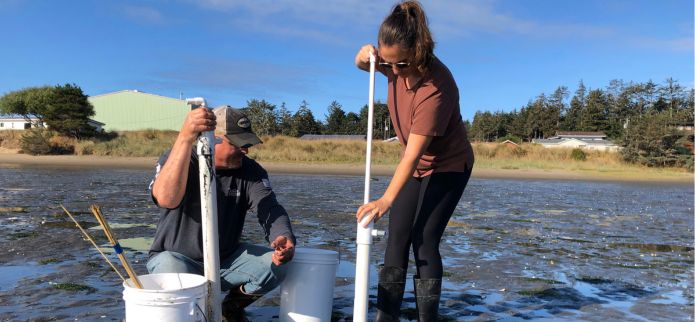
Clammers on the Coos Bay mudflats using a PVC clam gun (tube) to dig up clams. This “PVC method” involves pushing a capped pipe into the sand around a clam’s burrow and pulling up a core of sand – hopefully with a clam inside!
Some of the best advice you will receive will probably come from one of the fishing experts at one of our local bait and tackle stores. Not only can they tell you when the best time of day to dig, but they can also help you make sure you have the right equipment- a bucket, a shovel (can be rented or borrowed), and/or a tube, a.k.a. a “clam gun.”
Most clams in Coos Bay live just a few inches to a couple feet beneath the sand. Look for round holes about the size of a nickel or quarter—often signs of gaper or butter clams. Once you spot one, you can dig with a shovel or use a clam gun to retrieve it.
- Shovel Method: Start about 6 inches from the clam’s “show” (the hole) and dig straight down with a small shovel, aiming to reach it from the side or underneath. Gapers may be 1–2 feet deep; butter clams and littlenecks are usually shallower. Go slow near the bottom—feel for the shell and pull it out gently to avoid breakage. Cockles are often just below the surface and can be found by raking or sifting the top few inches—kids love this “clam treasure hunt.”
- Clam Gun Method: Place the “gun” (usually made from a PVC or stainless steel tube) over the show hole, push it straight down, cover the top to create suction, and pull up a plug of sand. This method can be effective for deep clams like gapers and works well in Coos Bay’s mudflats. It’s easier on your back and helps prevent the hole from collapsing. No clam gun? No problem—a shovel works just as well, and some locals even prefer it. Try both and see what works best for you—either way, expect to get muddy and have fun.
We could tell you more, but it’s easier to show you—these videos demonstrate what to look for and how to find clams:
Congratulations – You’ve Filled Your Bucket with Clams! Now What?
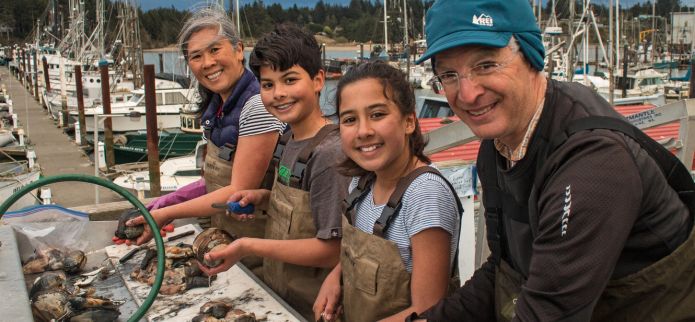
Rinse them in bay water before leaving the flats—many clammers bring a separate bucket. Once home or back at camp, clean and prep your catch. Some local campgrounds and RV parks, like Bay Point Landing , will even have clamming equipment and cleaning stations. Gaper and butter clams may need purging: soak them in saltwater or seawater for a few hours (or overnight) to help expel sand. Cockles and littlenecks usually need less soaking, but a quick rinse won’t hurt.
For cleaning, local bait shops can offer tips, but in general, steam or open the shells, remove the dark parts, and rinse the meat. Then it’s time to cook your favorite clam recipe- the options will make your mouth water. Here are just a few:
- Clam chowder is an Oregon Coast classic – the large gaper clams (also known as horseneck or empire clams) are perfect chopped up in chowder.
- Steamed Clams. If you have butter clams or littlenecks, try steaming them with garlic and butter, or toss them with pasta with white wine and parsley.
- Breaded and fried. Cockle clams are a bit chewy and are wonderful breaded and fried as crispy clam strips or fritters.
Safety and Stewardship: Enjoying Clamming Responsibly
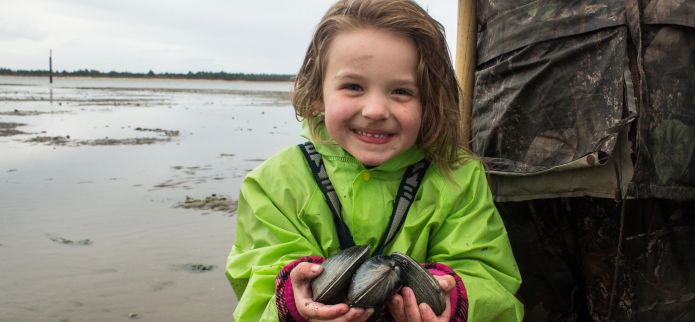
Clamming is a generally safe, enjoyable, and family-friendly activity that offers a hands-on way to connect directly with Oregon’s ecosystems. However, it’s essential to approach this activity with care—for both your safety and the health of the environment. Please keep the following safety & stewardship tips in mind on your next dig:
- Watch the Tide: Always track the tide schedule. It’s easy to lose track of time on the flats, and water can fill in behind you quickly. Know when high tide returns, and give yourself plenty of time to return to shore.
- Be Aware of Conditions: Watch for currents and sneaker waves in areas near channels or the ocean. Never turn your back on the ocean, and keep an eye on the surf. Use a buddy system and watch for soft mud or uneven ground.
- Respect the Environment: Fill in your holes to protect others and help the flats recover. Only harvest what you’ll use, stay within legal limits, and return unwanted live clams gently to the sand. Avoid protected areas and follow posted signs.
- Clean Up Properly: Don’t leave shells or innards on the beach or dock. Bag and dispose of them properly—or bury them below the high tide line. It’s often best to clean clams at home or your campsite.
- Make It a Family Activity: Clamming is fun for all ages. Kids love spotting clams and exploring tide flats, and it’s a great chance to teach them about marine life, tides, and responsible harvesting.
Ready, Set, Clam!
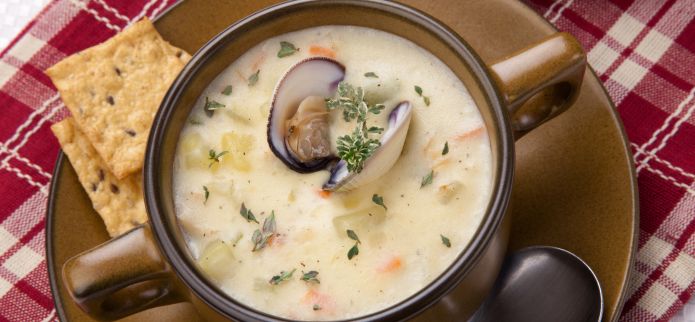
From the quiet of the low morning tides to the fun of digging in the sand with friends or family, clamming on Oregon’s Adventure Coast: Coos Bay, North Bend, Charleson is genuinely an activity anyone can enjoy - no special skills or pricey gear required! Even better, your reward is fresh, local seafood you harvested yourself.
Be sure to visit our featuredadventures page andtrip ideas page to find more travel ideas and inspiration. You can also followOregon’s Adventure Coast on Facebook, @travelcoosbay on Instagram, and TikTok to find inspiration on the best spots to visit, eat, stay, and explore any time of the year.
Additional Resources:
- Clamming on the Oregon Coast | Oregon’s Adventure Coast
- Where to crab & clam in Coos Bay - Oregon Department of Fish & Wildlife
- How-to and where-to dig for clams on Oregon’s coast - Oregon Department of Fish & Wildlife
- Head South for Some of the Best Crabbing and Clamming on the Oregon Coast - Travel Oregon
- Guided Clamming and Crabbing Adventures on the Oregon Coast - Travel Oregon
- Oregon shellfish regulations | Oregon Department of Fish & Wildlife
- Oregon Department of Agriculture
- Things to do in Charleston, Oregon - Pacific Charter Services Please note: While some information on this website may be outdated, the clamming details remain current and reliable.
